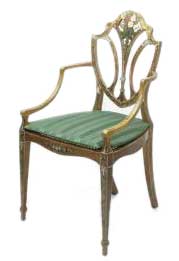George Seddon & Sons Furniture & Biography
The Seddons were engaged in cabinet-making since the days of George II, but their name sprang into eminence in London at the end of the 18th century, making furniture in many fashionable styles. George Seddon subscribed for a copy of Chippendale's "Director" in 1754, and he was presumably at that period one of the great master's disciples. In 1770, or at about the time when Robert Adam had evolved his new fashion, Seddon was in business at 151, Aldersgate Street (from Kent's "London Directory"). In the same year, Baldwin's "Guide" speaks of him as occupying premises at 158, Aldersgate Street, though Kent continues to place him as at 151 in the directories of 1771-1780.
Like Gillow, of Lancaster, Seddon had other irons in the fire and carried on a business as a silk mercer, a very useful adjunct to the calling of an upholsterer. In 1754, George was the cabinet-maker and Robert Seddon managed the silk business, and it would seem that the houses 151 and 158, Aldersgate, were utilised for the two businesses. Shortly after 1780, George Seddon took his sons into partnership, the firm trading under the designation of G. Seddon and Sons.
In 1789, one Thomas Shackleton, an upholsterer of 115, Long Acre, was an important assistant of the Seddons, who were then cabinet-makers and upholsterers at 150, Aldersgate Street, according to Loundes' "Directory", and in 1791 Kent's "Directory" records that Shackleton had been taken into partnership and the new designation, from which this information is gathered, appeared in the style Seddon, Sons et Shacleton (sic), Cabinet-makers and Upholsterers of 150, Aldersgate Street. Shackleton was probably brought into the business to supervise and develop the upholstery department.

1790, Painted satinwood dining chair, with caned seat, by Seddon, Sons, and Shackleton. The shield back design is in the style of Hepplewhite chairs.
In his charming "History of English Furniture", Macquoid has stated "it is probable that Seddon was making a great deal of fashionable furniture as early as 1770",and he proceeds to quote the "Annual Register" for 1768, as follows :"A dreadful fire burnt down London House, formerly the residence of the Bishops of London, in Aldersgate Street, now occupied. by Mr. Seddon, one of the most eminent cabinet-makers in London (the italics our own). The damage is computed at £20,000". This disaster may have led to the changes, temporary or permanent, which are recorded in the firm's addresses.
The Seddons were, therefore, practising as contemporaries of Thomas Chippendale and his school, and were participants in the evolution of the Adam vogue. They were at work side by side with George Hepplewhite and William Shearer, and, equally with these masters, they helped to model the new taste in design of which the root principle lay in Robert Adam's teachings. It may be confidently laid down that George Seddon carried out many commissions for Robert Adam and we can see the latter's influence cropping up in any Seddon cabinet-work we happen on.
The founder of the firm retired at approximately the time when Thomas Sheraton moved from Stockton to London. His sons, Thomas and George, carried on the business assisted by Shackleton over the so-called "Sheraton" period, George Seddon had two grandsons, both of whom attained celebrity - the one as an architect, the other as a pre-Raphaelite painter.
In 1802-3, Shackleton either died or retired from the business, which then came to be styled T. and G. Seddon, upholsterers and cabinet-makers, of 150, Aldersgate Street, and so appeared in the "Post Office New Annual Directory". To this head office a branch was added at 24, Dover Street, under the designation of Seddon et Co., upholsterers and cabinet-makers. In 1810 the " Post Office Directory" mentioned George Seddon and later Seddon et Blase, upholsterers and cabinet-makers, of 24, Dover Street.
In 1817, Kent's and the Post Office Directories changed the designation to Thomas Seddon, of 150, Aldersgate Street, revising this to Thos. arid Geo. Seddon in 1820. In 1826, T. et G. Seddon further added 16, Lower Grosvenor Street, and came to style themselves cabinet manufacturers. The history of this firm can be traced for over 100 years, and their name has always been associated with the finest of craftsmanship. Main interest, naturally, attaches to the productions of the first George Seddon, Chippendale's contemporary, and of the firm's eighteenth-century output.
When Chippendale's workshops were burned down, the tool-chests of twenty-two workmen were lost ; when Seddon's business house in Aldersgate Street was destroyed by fire the damage was computed at £20,000, and this at a time when the building of a sideboard carcase cost in labour £3!
The Seddons supplied much furniture to Windsor Castle, and they worked for the nobility and gentry of England. They did not subscribe for a copy of Sheraton's "Drawing Book" in 1791, and we may assume that they were well content to persevere with their own models and to observe their own principles in decoration. It would appear that Sheraton was ignored by them, that he did not have the run of their workshops, and that the firm was one of those against which Sheraton fulminated on the grounds of lack of support and facilities for the enrichment of his book.

Cabinet panels designed by George Seddon.
The panels illustrated here were selected from a notable cabinet which R. W. Partridge purchased. This wonderful cabinet was built to the order of the King of Spain (Charles IV), and was finally completed by the Seddons on June 28th, 1793. Designed by George Seddon, the cabinet-work was entrusted to R. Newham, the foreman cabinet-maker to the firm. The panels were subsequently painted by William Hamilton, R.A. and are today held to be some of the best examples of that great artist's handiwork.
